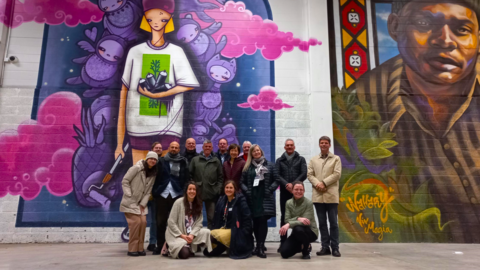Europe-wide CityLoops project sped up circular economy in Espoo

Did you know that leaves that fall from trees in the autumn can be used to make biochar or bokashi compost to be used in the city’s future gardens? Or that concrete and slabs from demolition sites can be used to build new houses? The European CityLoops project developed innovative methods and tools for planning the circulation of construction and demolition materials and organic waste in cities.
In 2020–2023, Espoo was involved in the Europe-wide CityLoops project(external link, opens in a new window), which developed innovative methods and tools for planning the circulation of construction and demolition materials and organic waste in cities. With the help of the circular economy solutions developed in the project, we can reduce the climate emissions of our growing city and take advantage of the local circulation of biomasses to absorb carbon dioxide. The final goal is to promote the transition to a circular economy, which will support Espoo’s goal of becoming carbon-neutral by 2030 and achieving the UN’s sustainable development goals as a pioneer by 2025.
Espoo was involved in the project as a replicator or follower city, which meant that we worked closely with seven European cities and learnt from their innovative experiments and new solutions. During the project, we exchanged lessons learnt especially with the cities of Roskilde and Høje Taastrup in Denmark and Apeldoorn in the Netherlands and participated in study trips to the pilot cities. As a replicator, we also utilise the solutions developed in these cities in Espoo in accordance with the replication plan drawn up in the project.
“Recycling and resource efficiency have been common practices in Espoo for a long time, but the city still has a lot of processes based on the linear economy. Promoting the circular economy requires know-how development,” says Tessa Armour, Urban Sustainability Specialist, who coordinated the CityLoops project at Espoo. “The best part of the CityLoops project was the exchange of ideas and experiences with other European cities and thereby increasing Espoo’s circular economy expertise. In addition, we are implementing two concrete replication measures in Espoo, which are related to sustainable plastic procurement and the circulation of biomasses.”
Impact through sustainable procurement
During the project, the CityLoops project partner, the Dutch Rijkswaterstaat (Ministry of Infrastructure and Water Management) developed a tool for examining the impact of the city’s procurements from the perspective of the circular economy. In the spring of 2023, our CityLoops partner used the tool to carry out a purchase data analysis on the City of Espoo’s procurements for 2022, with the help of which we sought a better understanding of the impact of our procurements as a whole. With the help of the analysis, we identified which procurement areas have the greatest potential to improve the recycling rate of plastics and established the role plastics play in different product groups.
Based on the results, we selected the procurement criteria for construction plastics as the next procurement development target. With the help of the procurement criteria, public sector operators can reduce the unnecessary use of plastic, promote the recycling rate of construction plastics and grow the market for recycled plastic. Construction plastics cover more than one-fifth of the plastic used in Finland. The circular economy of construction plastics requires the development of the planning of construction projects, better identification of the plastics used in construction as well as the improvement of construction site practices, separate collection, recycling systems and, ultimately, the utilisation of plastic waste. Many operators in the construction and plastic industry have already committed to the Green Deal of Construction Plastics(external link, opens in a new window), which sets recycling targets for, for example, construction film plastics.
“Cooperation with the CityLoops partners to develop circular economy procurements has been rewarding. With the help of the purchase data analysis, we gained new insights on how public procurements can impact the recycling rate of plastics. The construction industry uses 15–20% of all plastic in Finland and a lot of construction takes place in Espoo. With the procurement criteria, we can guide the market to operate more sustainably,” says Tiia Tuuri, Development Manager of the Closed Plastic Circle – from Pilots into Practice project.
Garden waste for a greener future
For some time now, the Espoo Public Works Department has been looking for a solution for the Espoo City Garden’s storage area in Vanttila, which is used as a composting area. The challenge has been the large amount of compost and its slow circulation. Inspired by the good CityLoops project results obtained by the City of Apeldoorn in the Netherlands, we decided to examine the utilisation of the bokashi model in more detail in the processing of leaf waste and in the improvement of the soil structure and quality. Bokashi is a fermentation process that turns organic waste into a soil improver. The composting method originates from Japan, where the word pair boka shi means fermented organic matter.
A small-scale bokashi experiment is planned to be launched at the Espoo City Garden in spring 2024. The soil improver compost resulting from bokashi will go to the city’s own green areas and may also be sold to substrate manufacturers. The aim of the bokashi demonstration is to prove the functionality of closed material flows and to make the management of green areas more environmentally friendly. Local or regional processing of garden waste has numerous advantages: it supports soil micro-organisms and microbial activity, facilitates the absorption of storm water into the soil even during heavy rains, increases the storage of water in the surface layers of the soil and increases the storage of carbon in the soil. Bokashi’s carbon footprint is also significantly smaller than that of a traditional thermal composter.
Read more about the results of the CityLoops project.(external link, opens in a new window)